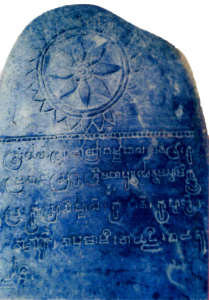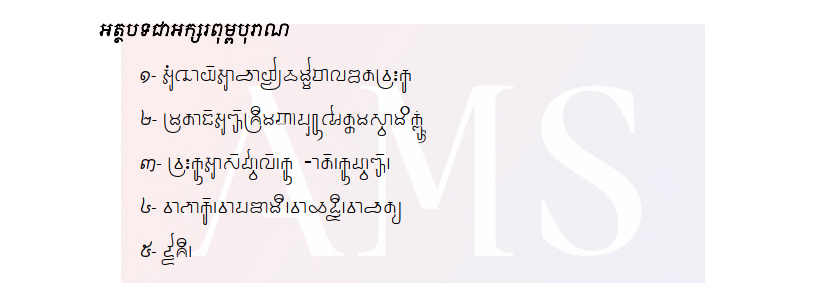កាលឆ្នាំ២០១៣ ខ្ញុំបានទទួលរូបភាពសិលាចារឹកមួយនេះពីលោក រុំ សិរីវិបុល។ លោកទទួលបានរូបនេះពីបងស្រីជីដូនមួយរបស់លោកឈ្មោះ កង ស្រីនាង ជាអ្នកប្រកបអាជីវកម្មថតចម្លងឯកសារនៅឃុំបែកចាន ស្រុកអង្គស្នួល ខេត្តកណ្ដាល។ កាលនោះ មានបុរសចំណាស់ម្នាក់ យករូបនេះមកថតចម្លងនិងអ៊ុតផ្លាស្ទិករឹង ធ្វើជាយ័ន្តសម្រាប់ដាក់តាមខ្លួនឱ្យបានសេចក្ដីសុខសប្បាយ និងរកស៊ីមានបាន។

អត្ថបទចារឹកនេះមានអក្សរចំនួន៥បន្ទាត់ និងអាចកំណត់បានយ៉ាងច្បាស់ថាជាអក្សរនិងភាសាខ្មែរសម័យមុនអង្គរ។ ផ្អែកលើលក្ខណៈតួអក្សរ យើងអាចប៉ាន់ប្រមាណថាសិលាចារឹកនេះចារនៅចន្លោះចុងស.វ.ទី៧និងស.វ.៨គ.ស.។ ថ្មដែលជ្រើសរើសមកចារ ទំនងជាប្រភេទថ្មថ្លើមអណ្ដើក ឬថ្មស្រទាប់ ដែលយើងតែងប្រទះឃើញជាទូទៅនៅសម័យមុនអង្គរ ជាពិសេស គឺនៅតំបន់ភាគត្បូងប្រទេស ក្នុងខេត្តកណ្ដាល តាកែវ កំពង់ស្ពឺ និងកំពត។ រូបរាងថ្មនេះគួរតែជាសន្លឹកសីមាដែលមានទម្រង់តាមធម្មជាតិ ពុំបានរចនារូបរាងនោះឡើយ។ ផ្នែកខាងលើអត្ថបទមានឆ្លាក់រូបចក្រមួយដែលផ្នែកខាងក្រៅរង្វង់ មានសញ្ញារាងត្រីកោណឬផ្លែចក្រ មានសណ្ឋានប្រហាក់ប្រហែលនឹងត្របកផ្កាឈូកចំនួន២៦។ បន្ទាប់មកមានខ្សែវ័ណ្ឌពីរ ឯផ្ទៃខាងក្នុងឆ្លាក់កាំចក្រចំនួន៨ ចំផ្ទៃកណ្ដាលចក្រមានឆ្លាក់រង្វង់តូចដែលមានដុំមូលនៅខាងក្រៅចំនួន៨ ព័ទ្ធជុំវិញខ្សែវ័ណ្ឌមួយខ្សែ។ យើងបានប្រទះឃើញសិលាចារឹកដែលមានសញ្ញាចក្រនៅខាងលើដូចគ្នានេះដែរ គឺសិលាចារឹកមកពីស្នាយពល K.៦៦ខ និងមួយទៀតជាសិលាចារឹកមកពីអង្គរបុរី K.១២១៦ ដែលមានរូបចក្រ សង្ខ ត្រីសូល និងវជ្រ។ នៅខាងក្រោមរូបចក្រ មានរចនាជាខ្សែបន្ទាត់ផ្ដេកមានក្បាច់ពងត្រីចំនួន៤៤។ ការរចនាខ្សែបន្ទាត់ជាក្បាច់ពងត្រីបែបនេះ យើងប្រទះឃើញច្រើនណាស់នៅសម័យមុនអង្គរដូចជា៖ K.៧៩, K.៣៦៧, K.៦៨៩, K.៧៨៤, K.៧៩០, K.៩៤០, K.១១៥០ និងក.២៧១៨ ជាដើម។
អត្ថន័យសិលាចារឹកខ្លីនេះ និយាយអំពីដង្វាយរបស់ អាចារ្យធម្មបាល (អាចាយ៌្យធម៌្មបាល) ថ្វាយចំពោះទេពព្រះនាមស្រីមហាបុរុសោត្តមស្វាមិ (ឝ្រីមហាបុរុឞោត្តមស្វាមិ) មានខ្ញុំបម្រើចំនួន៧នាក់ ស្រី៣នាក់ ប្រុស៤នាក់។
អត្ថបទនេះ ដកស្រង់និងសម្រួលពីអត្ថបទដែលធ្លាប់ចុះផ្សាយក្នុងទស្សនាវដ្ដីកម្ពុជសុរិយានាពេលកន្លងមក។ ខ្ញុំយកមកផ្សាយជាថ្មីនៅទីនេះ ដោយសង្ឃឹមថានឹងអាចរកឃើញទីតាំងពិតប្រាកដរបស់សិលាចារឹកនេះ។

អត្ថបទជាអក្សរខ្មែរទំនើប
១- អំនោយ៑អាចាយ៌្យធម៌្មបាលឰតវ្រះក
២- ម្រតាង៑អញ៑ឝ្រីមហាបុរុឞោត្តមស្វាមិក្ញុំ
៣- វ្រះកុអាស៑ហ៌្វល៑១ កុ {១} ាត៑១ កុ(ហ្វ)ញ៑១
៤- កុភាក៑១ វាបញ្ចមី១ វាឆដ្ឋី១ វាចតុ
៥- ទ៌្ទឝី១
អត្ថបទសម្រួលជាភាសាខ្មែរទំនើប
តង្វាយ(/អំណោយ)របស់អាចាយ៌្យធម្មបាល ចំពោះព្រះគម្ដែងអញស្រីមហាបុរុសោត្តមស្វាមិ។ ខ្ញុំ(បម្រើ)ព្រះមាន កុអាសរវល់១ កុ -ាត១ កុហ្វញ១ កុភាក១ វាបញ្ចមី១ វាឆដ្ឋី១ វាចតុទ្ទសី១។
វាក្យសព្ទ
– កុ = ពាក្យហៅស្ដ្រីវណ្ណៈថ្នាក់ទាបឬជាអ្នកបម្រើនៅសម័យមុនអង្គរ(Pou, 2004, p. 101)។ ឬមានន័យថា នារី ស្ដ្រី ប្រពន្ធ(ជាពាក្យសម្រាប់ហៅនារីដែលជាអ្នកបម្រើនៅប្រាសាទឬវិហារនានា) (ឡុង, ២០០០, p. 120) សម្រាប់ប្រើតែនៅសម័យមុនអង្គរប៉ុណ្ណោះ។
– វា = ពាក្យហៅមនុស្សប្រុសជាពិសេសមនុស្សថ្នាក់ទាបឬអ្នកបម្រើនៅសម័យមុនអង្គរ (Pou, 2004, p. 427)។ – វ្រះកម្រតាង៑អញ៑ = ជាពាក្យសម្រាប់ហៅអាទិទេពនិងទេវៈ (ឡុង, ២០០០, p. 102,) ប្រើតែសម័យមុនអង្គរ។ ពាក្យនេះនៅសម័យអង្គរប្រើជា «វ្រះកម្រតេង៑អញ៑» ពាក្យបច្ចុប្បន្នក្លាយជា «ព្រះគម្ដែងអញ»៕
————————————–
From Inscription to Yuan
In 2013, I received a picture of this inscription from Mr. Rom Serey Vibol. He got this picture from his cousin Kang Srey Neang, who runs a photocopying business in Bek Chan commune, Ang Snoul district, Kandal province. At that time, an old man took this picture and printed it into hard plastic as Yantra for his lucky, happiness, and business.
This inscription consists of 5 lines of letters and can be clearly defined as the letters and the Khmer language of the pre-Angkorian. Based on the written character, we can estimate that this inscription was written between the end of the 7th century and the 8th century.
The stone selected for inscription is likely to be a type of core stone or layered stone that we often see in the pre-Angkorian, especially in the southern part of the country in Kandal, Takeo, Kampong Speu, And Kampot provinces. The shape of the stone should be an Sīmā (Buddhist ritual boundary) with a natural shape, not any designs.
There is a Chakra at the upper part of the inscription. Its shape is likely the 26 leaf of the lotus. Then there are two circle shapes within the inner Chakra is carved with eight radiuses, the center of which is carved with a small circle with eight on the outside and around of outdoor circle.
We found the same inscription with the Chakra symbol above, the inscription from Snipol K. 66b, and the other inscription from Angkor Borey K.1216 with the Chakra (disk), conch, Trident, and Vajra. Below Chakra designed a horizontal line with 44 oval motifs. The design of the line as an oval motif, we see a lot in the pre-Angkorian, such as K.79, K.367, K.689, K.784, K.790, K.940, K. 1150, and A.2718 and so on.
The meaning of this inscription is about the offering of Ācāryyadharmmapāla to the deity named Śrīmahāpuruṣottamasvāmi with seven slaves, three females and four males. This article is an excerpt from an article published in Kampuchea Sorya magazine. I republish it here, hoping to find the location of the inscription.
អត្ថបទដើម៖ លោក ហ៊ុន ឈុនតេង






